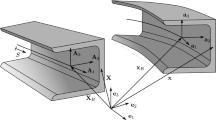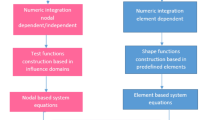Abstract
The discrete element method (DEM) that has recognized as a powerful numerical analysis tool is used in many scientific and engineering fields because it has a great potential to analyze the dynamic behavior of solid, granular, and fluidal materials in discrete manner. However, when DEM is applied to simulate massive material handling cases, the computational cost of DEM becomes a critical issue. Therefore, there are growing needs to reduce computational cost by finding mechanistically reasonable scale adjustment factor or method without losing the similarity or similitude of discrete element analysis for given laboratory or field conditions. In this paper, a mechanics-based scaling method for static liquid bridge model to reduce computational time is suggested by utilizing the existing scaling factor determination method with particle replacement concept. Although the method needs to be improved by introducing contact model property adjustment method for more realistic simulation, it can be applied for the static liquid bridge model to reasonably simulate the fluidal behaviour of particles with reduced computational time in discrete element analysis.
Access provided by CONRICYT-eBooks. Download conference paper PDF
Similar content being viewed by others
1 Introduction
1.1 Background
The discrete element method (DEM) is used in many engineering areas because it is very useful numerical analysis tool to evaluate the motions and interactions of granular, solid, and fluidal particles in various scales. However, even though DEM has distinguished advantages comparing to continuum mechanics-based numerical analysis methods, the impractical computational cost of DEM is known as one of critical obstacles that deteriorates the application of DEM.
To satisfy the growing needs for reducing computational cost without losing the advantages of DEM, replacing existing particles by a scaled-up particle with adjusted contact model could be considered as possible alternative. In addition to, if the alternative is suggested based on mechanistic theories, uncertainty and error that may be caused by trial and error approach can be avoided. A considerable theoretical framework to develop a mechanics-based scaling method for laboratory test or DEM has been suggested by Feng in a couple of papers [1, 2]. In the papers, the scale factor determination method based on three basic quantities such as length, mass, and time was suggested and, at the same time, the limitation of the dimension analysis that is used to evaluate the similarity between physical and scaled conditions in fluid mechanics was pointed out. Although the completive method to utilize coarse graining concept was not suggested in the papers, the scale factor determination method and the scale invariant property concept seem to be a reasonable components of framework to develop a mechanic-based computational time reduction technique for DEM. However, as described in the papers, since both exact scaling approach and partial scaling approach utilize the same scale factor for radius of particles and geometries in the analysis domain, any reduction in computational time cannot be expected without further improvement in the method and concept. To suggest a mechanistic-based material property scaling method for static liquid bridge model in DEM, the partial scaling method is utilized with particle replacement concept in this paper. In the method, existing particles are replaced by a scaled-up particle whose volume is exactly same as the existing particles. Also, the scale factor to adjust the material property such as surface tension is determined by utilizing three basic quantities and the characteristics of dimensionless force-distance curve. Although the method needs to be further improved by introducing contact model property adjustment method for more realistic simulation, it was found that the method shows acceptable results for given boundary flow condition of particles.
2 Similarity and Liquid Bridge Model
2.1 Similarity Principle
The similarity principle in fluid dynamics suggests geometric, kinematic, dynamic similarity as the criteria that should be satisfied to ensure the similarity of the scaled- laboratory test or numerical simulation to given physical condition. The similarities in numerical simulation is usually checked by many of dimensionless variables such as Reynolds number, Froude number, and Weber number, which represent the ratios of inertial force to viscous force, gravity force, and surface tension, respectively. These dimensionless variable have been developed by many of research groups for a long time and they are proven to be effective to acquire reliable similarity for given physical condition. However, research activities related to the similarity in DEM has been made by limited number of researchers and Feng and Owen are only researchers who try to suggest a mechanics-based similarity concept that can be applicable for discrete element analysis in author’s best knowledge. In his papers [1, 2], three basic quantities such as length \( ({\text{L}}) \), density \( (\uprho) \), and time \( ({\text{T}}) \) are utilized to determine scale factor for resized particles and geometries depending on the scale invariant property of contact models. However, as mentioned, any reduction in computational time cannot be expected when the scale factor determination is performed by following Feng’s current approach [1,2]. To figure out this issue, a scaled-up particle that replaces a group of particles can be suggested as one of the simplest approaches. In this case, the scale factor \( ({\text{S}}_{\text{f}} ) \) that is applied to determine the radius of the scaled-up particle can be used to determine the volume \( (\bar{V}) \), mass \( (\bar{m}) \), and contact model properties of the scaled-up particle. There still remain issues of how to consider the effects of compact degree and interactions of the physical particles in the contact model for scaled-up particle but the effects are assumed to be insignificant in this paper. Based on the assumption, this scaled-up particle concept becomes more reliable when continuous particles that are small enough against the characteristic length of geometries are considered in the analysis. Figure 1 shows the volumetric relationship between physical particles and scaled-up particle that are determined by utilizing Feng’s scaling method and the replacement concept.
2.2 Static Liquid Bridge Model
As known, the liquid bridge model is very useful contact model to simulate the capillary-induced force between small particles. Several types of liquid bridge model s such as static, dynamic, and multi-contact liquid bridge model s are used to simulate cohesive behavior of powders in a fluidized bed or in centrifugal tumbling granulator. The solution of the liquid bridge model can be obtained by using Laplace-Young equation and thetroidal approximation [3]. However, the solutions are not able to provide explicit function of liquid bridge volume and separation distance which have to be updated for every time increment in numerical analysis and, therefore, they cannot be utilized without further improvement. For the reason, the explicit form of dimensionless equations that have been suggested by Mikami et al. [5] are widely used to implement the static liquid bridge model in DEM [4]. They are presented by the regression expressions which are determined from numerical solutions of the Laplace-Young equation for various conditions. Equations (1)–(8) represent the capillary force, dimensionless capillarity force, dimensionless separation distance, dimensionless volume of liquid, volume of liquid between the same size of particles, and regression coefficients in Mikami’s expressions, respectively. The advantage of using dimensionless force, volume, and distance are that static liquid bridge force between two particles at any distance for given contact angle and moisture content can be determined by using a single smooth regression equation as shown in Fig. 2.
Dimensionless liquid force vs. dimensionless distance [5]
3 Application of Similarity Principe for Liquid Bridge Model
3.1 Stress-Based Similarity
According to the suggested scaling concept [1, 2], when a scale factor \( (S_{f} ) \) is applied only for length among three basic quantities, the volume and mass of scaled-up particles can be calculated as shown in (9) and (10).
Because the dimensionless force between particles are not affected by surface tension as shown in (2), the dimensionless force against dimensionless distance for different size of particles curve remains smooth at fixed contact angle and moisture content regardless of variation of surface tension. Figure 3 represents the dimensionless force against dimensionless distance between particles for selected radius when the scaling method with replacement concept is applied. Table 1 shows detail parameters for the conditions.
The motion and interaction of particles in DEM are governed by force-distance relationship, but evaluating contact stress between particles is necessary to check the similarity of scaled-up particle to a group of particles replaced. The approximated stress of particle can be calculated by following equation. However, the smoothness of force-distance is lost in this case.
When \( \bar{\gamma } = \gamma S_{f} \) is used instead of \( \bar{\gamma } = \gamma S_{f}^{3} \) in (12), the stress-dimensionless distance curve remain smooth as shown in Fig. 4 which seems to guarantee the similarity of scaled-up condition to physical condition up to a certain particle size. Figure 5 represents selected results of min-cone test simulation for \( \bar{\gamma } = \gamma S_{f} \) (lower 3 figures) and \( \bar{\gamma } = \gamma S_{f}^{3} \) (upper 3 figures).
4 Conclusion
A mechanics-based scaling method for static liquid bridge model to reduce computational time is suggested by utilizing the existing scaling factor determination method with particle replacement concept. The method can be applied for the static liquid bridge model to reasonably simulate the fluidal behaviour of particles with reduced computational time in discrete element analysis. The scale factor to adjust surface tension is determined by utilizing three basic quantities and the smoothness of dimensionless force-distance curve. Although the method needs to be further improved by introducing contact model property adjustment method for more realistic simulation, it was found that the method shows acceptable results for given boundary flow condition of particles.
References
Feng, Y.T., Han, K., Owen, D.R.J., Loughran, J.: On upscaling of discrete element models: similarity principles. Int. J. Comput. Aided Eng. Softw. 26, 599–609 (2009)
Feng, Y.T., Owen, D.R.J.: Discrete element modelling of large scale particle systems—I: exact scaling laws. Comput. Part. Mech. 2, 159–168 (2014)
Fisher, R.A.: On the capillary forces in an ideal soil; correction of formulae given by W.B. Haines. J. Agric. Sci. 16, 492 (1926)
Remy, B., Khinast, J.G., Glasser, B.J.: Wet granular flows in a bladed mixer: experiments and simulations of monodisperse spheres (2012). doi:10.1002/aic.13743
Mikami, T., Kamiya, H., Horio, M.: Numerical simulation of cohesive powder behavior in a fluidized bed. Chem. Eng. Sci. 53, 1927–1998 (1998)
Acknowledgments
This research was supported by a grant (15TLRP-C099511-01) from Transportation and Logistics Research Program (TLRP) funded by Ministry of Land, Infrastructure and Transport of Korean government.
Author information
Authors and Affiliations
Corresponding author
Editor information
Editors and Affiliations
Rights and permissions
Copyright information
© 2017 Springer Science+Business Media Singapore
About this paper
Cite this paper
Yun, T., Park, H. (2017). Applicability Evaluation of Similarity Principle in Discrete Element Analysis. In: Li, X., Feng, Y., Mustoe, G. (eds) Proceedings of the 7th International Conference on Discrete Element Methods. DEM 2016. Springer Proceedings in Physics, vol 188. Springer, Singapore. https://doi.org/10.1007/978-981-10-1926-5_14
Download citation
DOI: https://doi.org/10.1007/978-981-10-1926-5_14
Published:
Publisher Name: Springer, Singapore
Print ISBN: 978-981-10-1925-8
Online ISBN: 978-981-10-1926-5
eBook Packages: Physics and AstronomyPhysics and Astronomy (R0)









